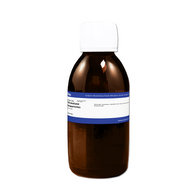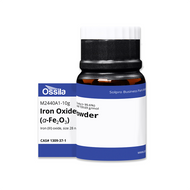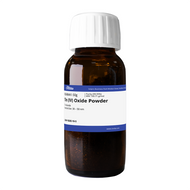An Introduction to Metal Oxide Photocatalysts

Jump to: Photocatalysis Mechanism | Examples | Metal Oxide Photocatalyst Requirements | Applications
Metal oxides are used as photocatalysts due to their ability to accelerate chemical reactions when exposed to light. Examples include zinc oxide (ZnO nanoparticles), iron oxide (Fe2O3 powder), titanium dioxide (TiO2 nanoparticles) which possess useful electronic structures, light absorption properties and charge transport characteristics suited to photocatalysis.
A photocatalyst is able to absorb light and generate an electron-hole pair which accelerate chemical reactions of other reagents or contaminants. Photocatalytic degradation is a highly efficient technique for eliminating pollutants from the environment.
Photocatalysis Mechanism
Metal oxide photocatalysts are semiconducting in nature. They have specfic electronic structures which allow them to absorb light and produce excitons. This process is described below:
Metal oxide is activated by absorbing light of a specific energy that is greater or equal to its bandgap.
An electron is excited and promoted from the valence band to the conduction band.
This forms an electron-hole (photogenerated) pair.
The photogenerated pair move to the surface of the metal oxide photocatalyst to react with adsorbed species.
The electrons reduce and the holes oxidize adsorbed compounds.
The photocatalytic activity of metal oxides from two sources:
- The generation of *OH radicals by oxidation of OH- anions
- The generation of *O2- radicals by reduction of O2. Both the radicals and anions can react with pollutants to degrade or otherwise transform them to lesser harmful by-products.
Examples of Metal Oxide Photocatalysts

Titanium Dioxide (TiO2) Nanoparticles
Most widely used photocatalyst, known for its maximum ability, stability, and non-toxicity.

Zinc Oxide (ZnO) Nanoparticles
Low cost, high photocatalytic performance, excellent physical stability and biocompatibility.

Iron Oxide (Fe2O3) Nanopowder
Narrow band gap (< 2.1 eV) and a vast absorption capacity in the visible light area.

Tin (IV) Oxide (SnO2) Powder
Band gap of ~ 3.6 eV, corresponding to activation with photons of a wavelength of 350 nm.

Tungsten Oxide (WO3) Powder
Visible-light sensitive, chemically stable and Earth-abundant.
Metal Oxides

Metal Oxide Photocatalyst Requirements
Suitable morphology
Since every chemical process within photocatalysis occurs at the surface of the metal oxide particle, the surface morphology is an essential feature in its efficacy. Photocatalytic properties are enhanced by the use of nanoscale metal oxide particles rather than bulk material. Quantum size effects, caused by limiting electron movement cause the conduction and valence band to become discrete energy levels. The redox potential of the CB and VB increases and so does the redox potential of the electrons and holes. As a result the nanoscale metal oxide photocatalyst becomes more reactive.
Desired band gap
The band gap refers to the energy difference between the valence band (VB) and the conduction band (CB) of the photocatalyst. When light is absorbed that is equal or greater in energy to this band gap energy then an electron-hole pair can form. The relationship between the wavelength and energy of light means that if you want your photocatalyst to be excited by specific wavelengths (i.e. visible light) then there will be a corresponding bandgap energy that will be best suited.
The band gap must also align with the energy requirements of the desired reaction. For a photocatalytic reaction to proceed, the conduction band minimum (CBM) of the photocatalyst must be more negative (higher in energy) than the reduction potential of the reaction you want to drive, and the valence band maximum (VBM) must be more positive (lower in energy) than the oxidation potential of the reaction. This ensures that the photogenerated electrons and holes have enough energy to drive their respective redox processes.
High surface area
High specific surface area is essential to maximize the photoactivity of metal oxide photocatalysts, therefore they are typically of nanoscale dimensions. The availability of additional atoms on the surface of the metal oxide improves the adsorption ability. The time it takes for electron-hole pairs to interact with the surface of the metal oxide nanoparticles determines the photocatalytic efficiency. If the particle is in the nanoscale range, the diameter becomes insignificant, and the transfer of electron-hole pairs from the interior to the surface is easy, increasing the rate of redox reaction. Due to the enhanced transport of electron-hole pairs to the surface of the catalyst, the chance of recombination is significantly decreased.
Stability
A photocatalyst must demonstrate stability towards photochemical change. It must not be degraded whilst enhancing other chemical reactions on its surface. Photocorrosion of a photocatalyst’s surface, leading to degradation of its catalytic efficiency is a serious issue. Anti-photocorrosions strategies include modifying the crystal structure or morphology of metal oxides, doping with heteroatoms, hybridizing with various semiconductors and/or cocatalysts, and regulating the photocatalytic reaction conditions.
Applications of Metal Oxide Photocatalysts
Environmental Remediation
Metal oxide photocatalysts have been used to remove contaminants including pesticides, organic and inorganic pollutants from wastewater. Access to fresh, clean drinking water relies heavily on the ability to remove these contaminants. Metal oxide nanoparticles have been widely researched for use in environmental remediation due to their tuneable morphologies, large surface areas, versatile surface chemistry and availability. For this application, water stability is crucial, and long-term recyclability is important to reduce the impact of their elevated reactivity. Magnetic iron oxide nanoparticles can be efficiently collected from treated water via magnets, allowing for their reuse across several cycles with very little reduction in efficiency.
For example, γ-Al2O3 has been extensively used to support adsorbents in dye adsorption due to its large surface area and wide band gap (7.0–9.5 eV).
Hydrogen Production
Photocatalytic water-splitting via metal oxide-based photocatalysts is one of the methods used to produce the solar fuel, hydrogen:
Photogenerated electrons in the metal oxide particles are promoted to the conduction band and reduce H+ into H2. The corresponding hole decomposes H2O on the metal oxide surface into O2 and H+. The hydrogen can then be used as a renewable energy resource. TiO2 nanoparticles is a common photocatalyst used for this application but suffers from electron-hole recombination issues. Sacrificial reagents have been used to increase photo-efficiency by keeping the photoexcited electrons separate from the holes. These sacrificial reagents include methanol, Na2SO4, ethanol, and Na2S and ions such as I−, IO−3, CN−, and Fe3+. Doping and modifying the metal oxide catalyst with transition metals, noble metals, graphite, and graphene has also be used to improve hydrogen production rate.
Learn More
 An Overview of Metal Oxide Nanoparticles
An Overview of Metal Oxide Nanoparticles
Metal oxide (MOx) nanoparticles (MONPs) are a class of nanomaterial with interesting and diverse chemical, optical, electrical and magnetic properties. Different metals bond to oxygen forming a variety of crystal structures under specific conditions. The shape and nanostructure of these materials effects their surfaces which in turn impacts the way they interact with light, electricity, magnetic fields and other materials.
Learn more... What are Transparent Metal Oxides?
What are Transparent Metal Oxides?
Transparent conductive oxides (TCOs) are metal oxides, such as zinc oxide and tin oxide, that are capable of conducting electricity whilst being optically transparent. This means they absorb a low number of electromagnetic waves within the visible region of the spectrum, appearing see-through.
Learn more...
References
- Metal oxides as photocatalysts, Khan, M. M. et al., Journal of Saudi Chemical Society (2015)
- Metal oxide-based photocatalysts for the efficient degradation of..., Miad, A. A. et al., Nanoscale Advances (2024)
- Preparations and applications of zinc oxide based photocatalytic..., Sun, Y. et al., Advanced Sensor and Energy Materials (2023)
- Highly efficient visible light active iron oxide-based photocatalysts..., Vijayarengan, P. et al., Scientific Reports (2024)
- Tin dioxide as a photocatalyst for water treatment:..., Al-Hamdi, A. M. et al., Process Safety and Environmental Protection (2017)
Contributors
Written by
Application Scientist
Diagrams by
Graphic Designer